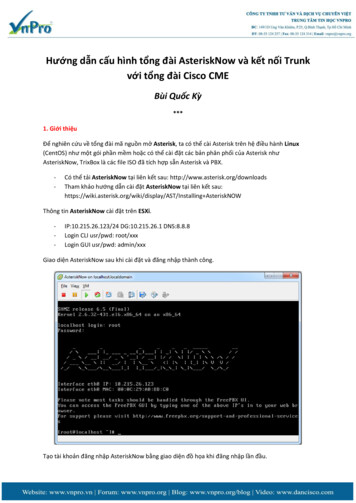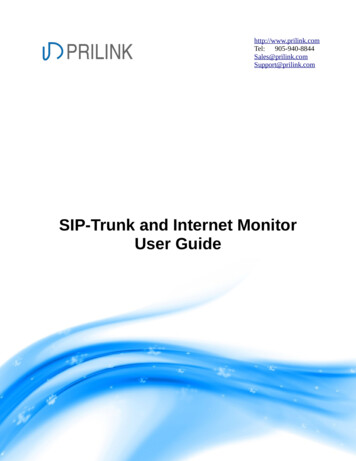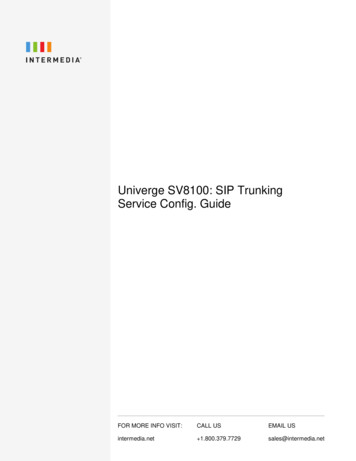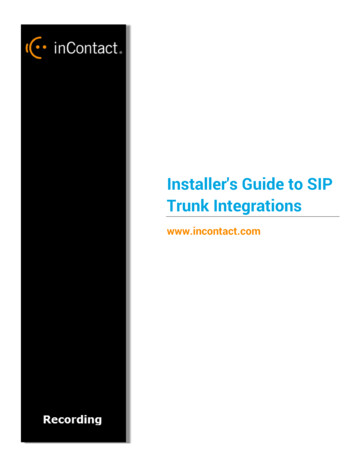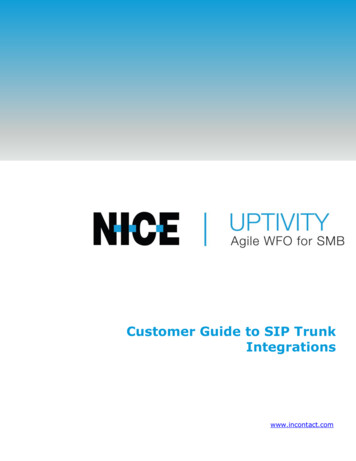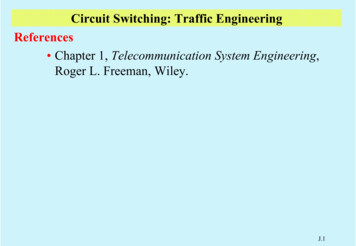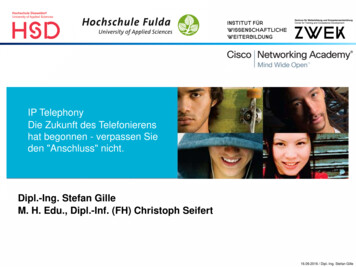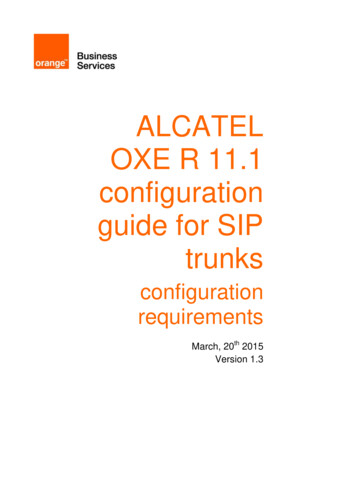
Transcription
Trunk Injection:Difficulties and ConsiderationsUte AlbrechtUF/IFAS Southwest Florida Research and Education Centerualbrecht@ufl.edu2020 Florida Citrus Grower’s Institute
What is trunk injection?o A targeted application of pesticides, plantresistance activators, fertilizers, or othermaterials into the stem or trunk of a woodyplant as an alternative to spraying or soildrenching (“Endotherapy”).o Injection occurs into the xylem (not thephloem), from where the materials are thendistributed throughout the plant with thetranspiration stream.
Advantages of trunk injectionsooooooPrecise delivery of crop protection materialsElimination of spray driftReduced risk for worker exposureReduced risk for non-target organismsReduced pesticide load into the environmentLengthening of the duration of time that appliedmaterials are biological active
Trunk injection useso Insects (leaf beetles, leaf hoppers, leaf miners, lacebugs, psyllids, mites, scales, aphids, thrips, whiteflies,mealy bugs, etc.)o Nematodes (wood nematodes)o Fungi (powdery mildew, blight, rust, scab, etc.)o Bacteria (bacterial blight, bacterial leaf scorch, Xylella)o Phytoplasmas (lethal yellows/bronzing)
Materials used for injectionooooImidaclopridEmamectin benzoateAcetamipridAbamectinSuppression of insects, mites,and nematodes of ornamentaltrees, non-bearing fruit andnut trees, coniferous trees,palm trees, and shrubs. Residential and commercial landscapes and other privateand public areas, urban areas, forest areas, and otheruncultivated non-agricultural areas.
Materials used for injectiono Propiconazoleo Phosphoric acidSuppression of fungal diseaseso OxytetracyclineSuppression of bacterial andPhytoplasma diseaseso Nutrientso Growth regulatorsPlant growth Non crop-bearing ornamental trees, large woody shrubs,and palms in urban environments and residential areas.
Diseases treated by trunk injectionsForestryo Oak wilt disease (fungal disease affecting the xylem)o Dutch elm disease (fungal disease affecting the xylem)o Emerald ash borer (feeds on the bark)o Pine bark beetle (feeds on the inner bark)o Sudden oak death (Phytophthora)
Diseases treated by trunk injectionsAgricultureo Apple - scab and fire blighto Avocado - root rot, thripsViticultureo Grapevine downy and powdery mildewOrnamentalo Palm lethal yellowing/bronzing
Methods of injectionMost technologies are drill-based. Few are no-drill (needle)-based.All require relatively large injection holes.
Drill vs. needle injectionDrilling ( large holes)o Risk of permanent damage to the sap wood (embolisms,callusing and compartmentalization of the vascular system)o Loss of chemicals due to untargeted nature of applicationo Easy entry side for pests and diseaseso Reduced tree vitality in the short and long termNeedle or blade injection ( smaller holes)o Less risk of permanent damage to the sap woodo More targeted application to the active zone of transport
Fast high-pressure injection
Slower medium pressure injection
Methods of injection
Low or no pressure transfusion
Concerns about any type of injectiono Logistical problems (time, labor, cost)ooooooooWounding of treesVessel destruction, cavitation and embolimsSecondary infectionsImpact on long-term tree vitalityImpact on pollinatorsResidues in fruitConsumer perceptionTime and resources to get label for use
Tree physiology
Long distance transport in plantsPhloemo Made up of living tubes (sieve cells and companion cells)o Transport of sugars and other organic compoundso Transport is bidirectional from source tissue (e.g. leaves)to sink tissue (e.g. roots and fruits)Xylemo Made up of non-living tubes (vessel elements and tracheids)o Transport of water and nutrientso Transport occurs from roots to stems to leaves
Phloemo Active transporto From source tissue (high sugarcontent) to sink tissue (lowsugar content)Xylemo Passive transporto Driving force is ocesses-ii/Directions of transport
rce/6716/digitalfirst content/trunk/test/hillis2e/asset/img ch25/c25 fig12.htmlTranspiration stream(Xylem)
Anatomy of a tree yer-structure/
Anatomy of xylem and phloemXylemvesselCLasPhloem
Xylem and phloem exchange is via the raysRayparenchyma
Dye injection studies
Young greenhouse grown treeHigh pressure injectionBelowAboveAboveAboveAbove
Natural uptake through roots
ComparisonInjectionRoot uptakeNatural transport is in the outer zones of the trunk, close to the bark.
Field-grown treeHigh pressure injectionBelowAboveInjection site
High pressure injectionInjection siteAbove injection site
High pressure injectionPhloemLongitudinal trunk sectionImmature fruit
Uptake studies
Low pressure transfusion0.5 cm2.0 cmUptake is influenced by the depth of delivery.
Low pressure vs passive transfusionLow pressurePassiveMore material is taken up when pressure is applied.
Uptake volumeMore injection ports increase the volume that can bedelivered into the tree.
Mobility depends on the chemical propertiesSafranin OAcid fuchsin
Mobility depends on the chemical properties
Trunk injury
Wound healingClosedOpenMostly closed Open, barkbut bark cracking crackingWidth: 3.175 mm (0.125”NecroticDepth: 5 mm (0.2”)
Wound healingBark cracking occurs frequently.
Take home messageso CLas resides in the phloem (not in the xylem).o Trunk injections deliver materials into the xylem (notthe phloem) from which the materials are distributedthrough the tree by the transpiration stream.o Different chemicals will vary in their mobility throughthe xylem and translocation to the phloem.
Take home messagesoooooTrunk injections will injure a tree.Phytotoxicity may occur.Xylem vessels may embolize.Secondary infections may occur at the injection site.One-time injections will not prevent recurrent insectcolonization and pathogen infections.The impact on long-term tree vitality or viability is unclear,especially when conducting repeated injections.
FundingDevelopment of an automated delivery system for therapeuticmaterials to treat HLB infected citrusUSDA-NIFA-SCRI-006650PD/Co-PDsDrs. Ozgur Batuman, Yiannis Ampatzidis, Ute Albrecht(UF/IFAS SWFREC)CoPIsDrs. Fernando Alferez (UF/IFAS SWFREC), Tara Wade (UF/IFASSWFREC), Nabil Killiny (UF/IFAS CREC), Amit Levy (UF/IFAS CREC),Veronica Ancona (Texas A&M), Louise Ferguson (UC Davis)
Ute AlbrechtUF/IFAS, Southwest Florida Research and Education Centerualbrecht@ufl.eduLeigh Archer (PhD student)
Drilling ( large holes) o Risk of permanent damage to the sap wood (embolisms, callusing and compartmentalization of the vascular system) o Loss of chemicals due to untargeted nature of application

